The role of antibodies
The three functions of antibodies
- Antibodies are secreted into the blood and mucosa, where they bind to and inactivate foreign substances such as pathogens and toxins (neutralization).
- Antibodies activate the complement system to destroy bacterial cells by lysis (punching holes in the cell wall).
- Antibodies facilitate phagocytosis of foreign substances by phagocytic cells (opsonization).
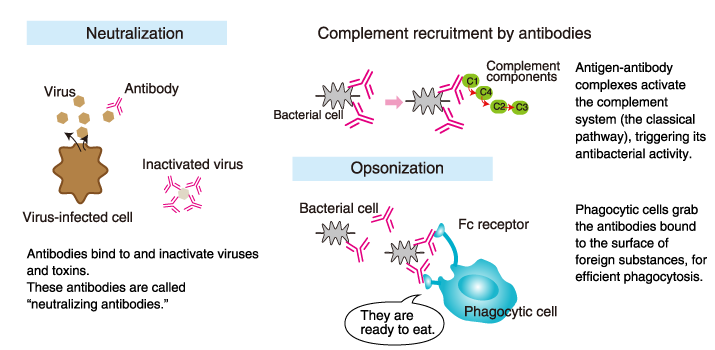
Antibodies and the four key features of the immune system
- Specificity of antibodies: Antibodies precisely recognize toxins and pathogens.
- Diversity of antibodies: Antibodies against a variety of antigens preexist in the body.
- Immunological memory: No recurrence of diseases such as measles.
- Immune tolerance: Self cells and tissues are not normally attacked.
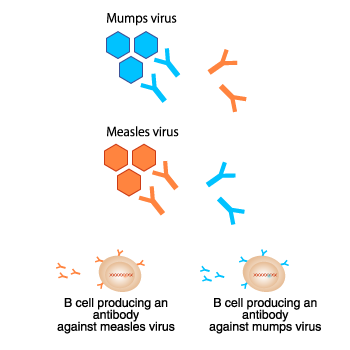 The specificity of antibodies
The specificity of antibodies
Each antibody recognizes one specific antigen. For example, an antibody that recognizes the mumps virus cannot recognize the measles virus. Conversely, an antibody that recognizes the measles virus cannot recognize the mumps virus. This feature is called “antibody specificity”.
Each B cell (antibody-producing cell) produces one kind of antibody. However, pathogens produce millions of harmful factors.
Then, how does the body defend itself against countless harmful factors?
The diversity of antibodies and immunological memory
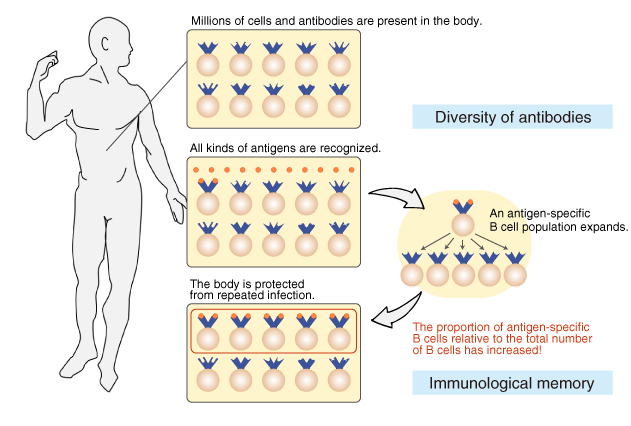
Tens to hundreds of millions of different B cells are circulating in the body so that every antigen is recognized. In other words, the body is prepared for the invasion of pathogens by possessing B cells that produce unique antibody molecules. This feature is called “antibody diversity”.
After an infection, the cells producing pathogen-specific antibodies multiply and increase proportionally. As a result, the body is protected from repeated infection. This feature is called “immunological memory.”
Gene arrangement
Antibody-producing B cells are produced in the bone marrow and mature in the periphery. During B-cell maturation, the antibody genes (immunoglobulin genes) undergo recombination, generating an enormous repertoire of antigen-binding sites (the variable region). This phenomenon is called “gene rearrangement.”
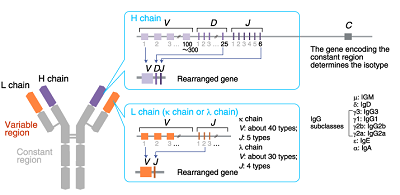
The gene locus encoding the H chain variable region:
The locus contains an array of about 100-300 V gene segments, about 25 D gene segments, and 6 J gene segments. One segment each of the V, D, and J gene segments are selected and joined together.
The gene locus encoding the L chain variable region:
There are two loci: κ and λ. The κ locus consists of an array of about 40 V and 5 J gene segments. The λ locus consists of an array of about 30 V and 4 J gene segments. One segment each of the V and J gene segments are selected and joined together.
Immunoglobulins (antibodies) to countless antigens are produced from a limited number of genes by recombination of gene segments. Gene rearrangements also occur during T cell maturation in the thymus.
Immune tolerance
“Why don’t tens to hundreds of millions of B cells recognize and attack self-tissues?”
Antibodies recognize all types of antigens, except self-antigens. This feature is called “immune tolerance.” B cells that react to self-antigens are generated, but are eliminated within the bone marrow. Even if some autoreactive B cells evade the elimination process and reach the periphery, those B cells that produce antibodies to self-antigens (autoantibodies) are inactivated by another mechanism including regulation by Tregs.
When these mechanisms are disrupted, “autoimmune disease” develops, characterized by immune cell-mediated self-tissue attack. Possible causes of autoimmune disease include viral infection, high fever, pregnancy, and the recently proposed abnormalities in the intestinal microbiome. However, the details of the mechanism remain unknown.
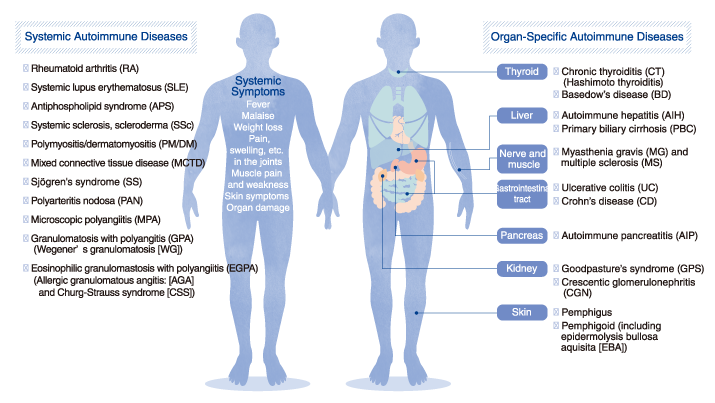
Download our free Pathway Posters
Related Links
*Antibody
→Antibody basics
→Antibodies as a research tool
- How to select antibodies
- Labeled antibodies
- How to label antibodies
- Main causes of non-specific reactions
- How to reduce non-specific reactions
- Tags and Tag antibodies
*Qualitative and quantitative measurements of proteins using antibodies
- Western blotting (WB)
- Enzyme-linked Immunosorbent assay (ELISA)
- Immunoprecipitation (IP)
- Co-immunoprecipitation (Co-IP)
*Fractionation and purification of proteins
Explore our free Webinar Series recordings



